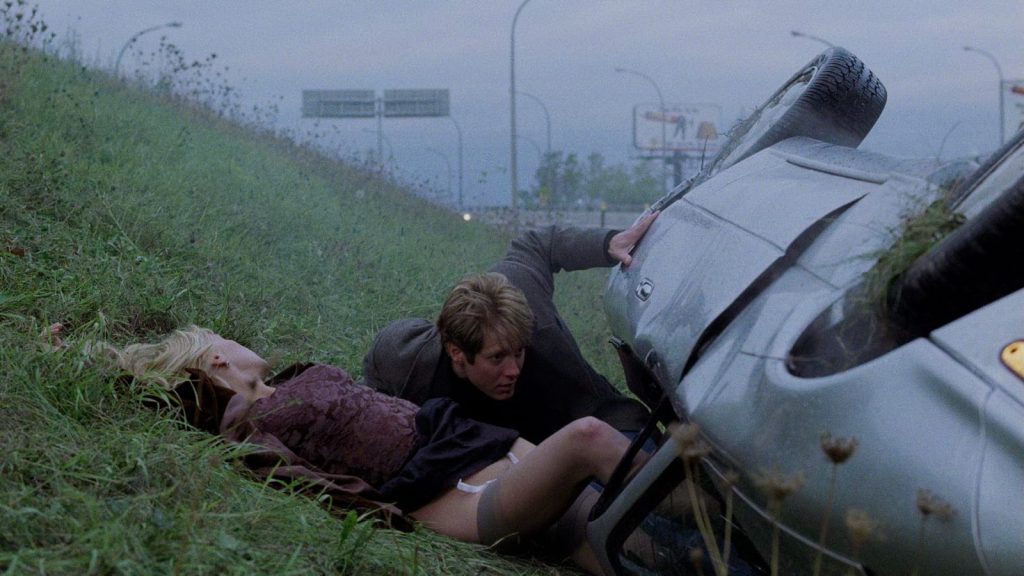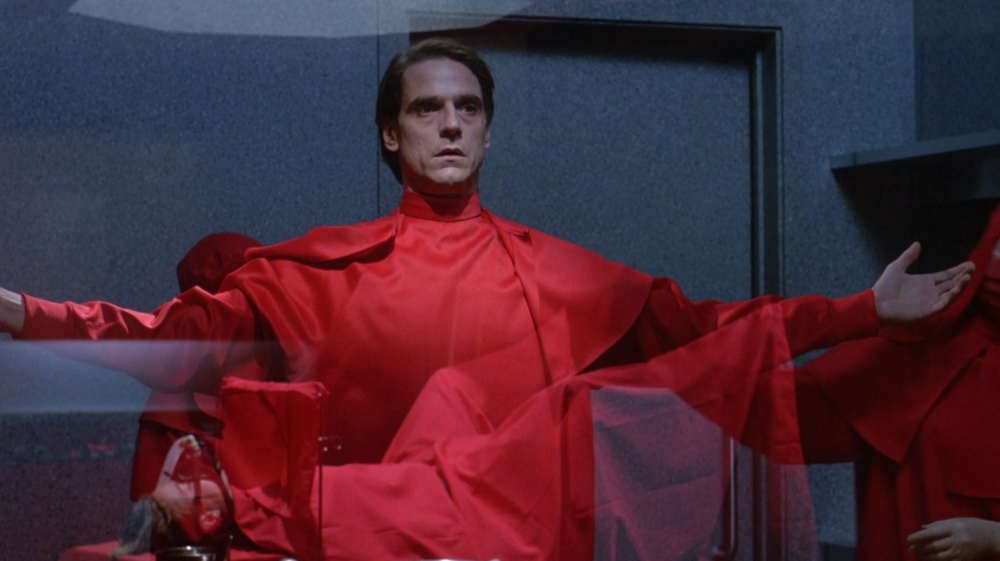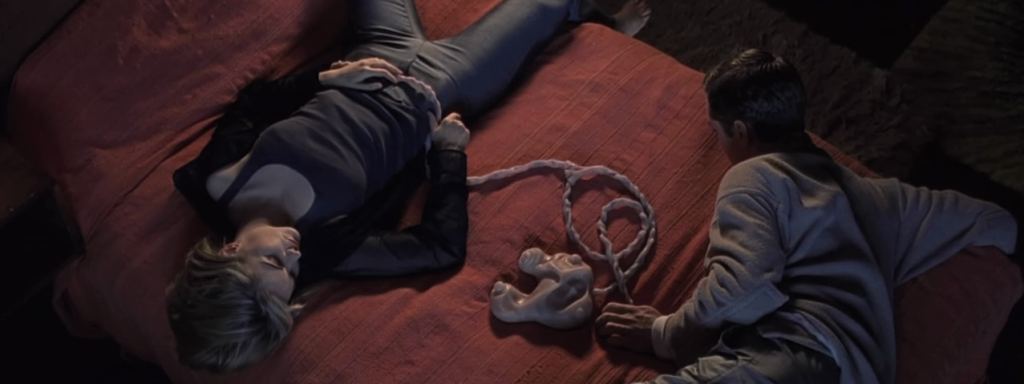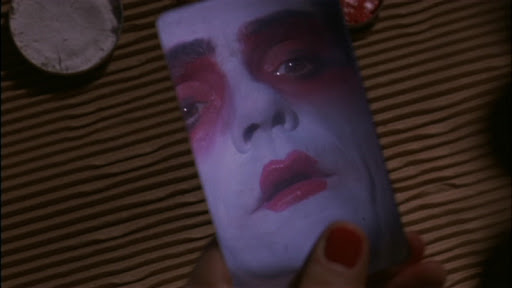The space occupied by the body as an inseparable component of the built environment has existed since perhaps the very inception of cinema as a medium. Examining the very beginnings of the medium, it is evident that Lumiere’s Workers Leaving the Lumière Factory (in contention with Roundhay Garden Scene as the first recorded motion picture) marked a fundamental shift in the workings of photography. No longer would the body exist as a mere imprint upon the environment it is situated within; instead, the introduction of motion rendered the body a living, breathing mass of flesh that disrupts the backdrop within which it resides. From the very beginning of the film, the frame melts into a sea of contrast, as the bodies exiting the factory occupy a greater capacity of the composition than the entrance of the factory itself. They exit in pairs, of husband and wife, of friends, of joint units, flowing spontaneously into two separate streams of movement. In Lumiere’s conception of cinema, the unifying force of labour seems to create a temporary coalescence between disparate bodies as a single unit. With what could be termed the birth of cinema comes the scrutinisation of the body, enforced by the lens of the camera, which may act as an agent of observation but will eventually grow into one of repression.
The body in cinema has now evolved to exist as a particularity, often conceived through the lens of the venereal (and often in conflict with the weightless psychological). There are few filmmakers with a more driven obsession with the body as a biological entity than David Cronenberg, whose name has become a descriptor with immediate ramifications, not unlike Lovecraft. To define the body, in the Cronenbergian sense of the word, would be a misstep, since the very lack of any consensus on what exactly the body constitutes is acommon concern across his filmography. It is at once a battleground for competing corporate technologies as in eXistenZ, and a vessel for the inhibition of violent tendencies in Eastern Promises. Upon further scrutinisation, however, the Cronenbergian body is not absent of any imposition of meaning. Quite often, it is constructed and analysed in gendered terms. It takes the form of an encapsulation of conflict between masculine and feminine conceptions of being, of an entity defined by its role in biological reproduction and of a veritable No Man’s Land that is in conflict with any imposition of gender. In exploring gender as a foundational element in Cronenberg’s work, it is paramount to sift through even the least ideologically aligned of these entries, such as Crash, since this element manifests itself in ways that are not immediately obvious.

The perceived foundations of gender in biological sex is perhaps the most apparent conception of the term. An early entry in his work, The Brood is very much a film concerned with gender as both subtext and surface text, since its very premise is based on the rift between a recently divorced couple. In casting the lead roles that would eventually go to Art Hindle and Samantha Egger, Cronenberg reportedly sought “vague facsimiles” of himself and his wife, thereby rendering the film a deeply personal one even before it is examined. The Brood would not exist without its thematic opposite, Kramer v Kramer, which presented a relatively cheery vision of a divorce that Cronenberg himself viewed as repulsive, thereby factoring into his decision to direct perhaps the bleakest film on divorce. In filming the dreadfully Canadian interiors of the film, DoP Mark Irwin frames bedrooms and theatre halls in dramatic contrast, with an emphasis on chiaroscuro that suggests a void beyond the narrow centers of light. These interiors are often framed in terms of opposites and imbalances, with the titular demonic Brood children staring from ceilings whilst adults lay collapsed on the floor. The wife of our (veritable) protagonist, Nola, resides in a psychiatric institution, clad in flowing white robes and in a symmetrical meditative pose until the very end of the film. Simultaneously, protagonist Frank Carveth is often in states of disarray, running through the icy Canadian landscapes in some sort of masculine endeavour. Hanging over The Brood is a constant paranoia and distrust between (former) husband and wife, with either party driven into panic by the idea of each other’s infidelity despite their status as divorcees. There is a certain bitterness to how these gendered roles manifest themselves in the form of the body; whilst Frank’s body is engaged in construction work and caring for his infant daughter, Nola’s body is in a state of limbo and relaxation. Yet, the introduction of the Brood of mutated children that commit the murders that drive them both together suggests a conception of the feminine body, and by extension reproductive potential, as a fundamentally diseased one. This Brood haunts Frank and his daughter not unlike the memory of his ex-wife haunts him, and their origin as larvae protruding from Nola’s flesh (thereby rendering the white robes a metaphor for the purifying ideal of femininity) frames the female body as a vessel for the eventual wreaking of vengeance against the careless male ego.
In a similar vein, his 1988 drama Dead Ringers situates the body as a zone of psychological conflict between the male professional and the female patient. The film marks the introduction of DoP Peter Suschitzky as a key Cronenberg collaborator, whose cinematographic approach continued to define Cronenberg’s work for the next 28 years. Though it metamorphosises over the course of Cronenberg’s career, much of Suschitzky’s work can be defined by his employing of the close-up, especially with regards to parts of the human body. In Dead Ringers, this stylistic approach is evident in how the growing rift between two identical twin gynaecologists, Elliot and Beverly Mantle (both played by Jeremy Irons in a career-best duo of performances), is framed. Cronenberg shoots surgical instruments as Leone would shoot a gun in a holster, always suggesting a capacity to mutilate and destroy. These objects, along with a range of other physical motifs, mediate relations between man and woman, suggesting a dependency on the latter for the physical aid of the former, but also the emotional dependency of the former on the latter. The aforementioned close-ups re-contextualise objects rooted in a medical context as signifiers of gender identity; rubber operating tubes become restraints, scissors become lynchpins and surgical instruments become tools that give rise to death instead of birth. They form a material architecture for the symbiosis between Elliot and Beverly, both of whom attempt to embody a form of masculinity exceeding the other by transgressing the borders of their relationship.

Symbiosis, as with disease, acts as a lynchpin connecting much of Cronenberg’s filmography- after all, the border between symbiosis and parasitism is a very narrow one. In Dead Ringers, the weakening of the body through symbiosis alters gendered relations. Claire, a burnt-out actor, serves as much of the rest of the objects in the Mantle twins’ lives: something to be shared in equal proportion, with either sibling taking the place of the other in something of a macabre circus act. The disruption of this equilibrium occurs, however, when Claire’s dependency on narcotics transfers to Beverly, resulting in the development of a crippling addiction. The hermetically sealed world of the Mantle twins, where women represent lab rats to be dissected and reproductive difficulties represent mere faults in equilibrium, collapses because the façade of professional machismo can no longer be upheld. A body-that is, the ontological Body comprising Mantle 1 and Mantle 2- is thrust into disarray in what could be interpreted as a hormonal imbalance, in that Beverly’s newly-developed symbiosis with Claire acts as the intrusion of the feminine into the world of the consolidated masculine. The maintenance of the twins’ sanity is dependent on the assumption that they will look into a mirror and see each other as a single, masculine entity- this fits into the framework of the Lacanian imaginary, which constitutes the fundamental narcissism by which the human subject creates fantasy images of both himself and his ideal object of desire. When this framework descends into limbo, the equations and identifications that make up the Lacanian imaginary are essentially destroyed. Therefore, the position of gender within the Lacanian arena’s three intrapsychic realms- symbolic, real and imaginary- is disrupted, leading to the development of a sort of gender dysphoria. In a desperate attempt to compartmentalize the masculine and feminine, the twins separate themselves into the mortal and ethereal realms via means of murder with the very instruments that acted as the foundation of their professional lives, and in a process, not unlike a Caesarean section.
If one were to pursue the thread of Lacanian psychoanalysis further throughout Cronenberg’s filmography, it would soon become evident that what initially appears to be a surface-level upholding of the gender binary via heteronormative relations as the foundation of much of his filmography (with some exceptions, such as Naked Lunch) is merely a thin film of narrative structure that dissolves swiftly upon further inquiry. This is because even the (ostensibly) rigid, violent masculinities of a film like Eastern Promises, which is very much rooted in the cultural boogeyman of masculine physicality representing a threat to traditionally feminine innocence, is based upon an unstable foundation of Oedipal complexes and, as in M. Butterfly and Cosmopolis, Brechtian performance. Furthermore, the body acting as a physical manifestation of the binary is similarly challenged through the mediation of gendered intersubjectivities via technology, which transplants and moulds the biological familiar in such a fashion so as to produce entirely new modes of being, where gender as a binary is a foreign concept.
This is perhaps most obvious in eXistenZ, a middle-period oddity that presents cyberspace as an arena for the refashioning of gender identity in the bluntest terms possible. As in Dead Ringers, Suschitzky’s use of high contrast and juxtaposition in close-ups frames the discomforting game consoles in the film as active challenges to our protagonist’s masculine hubris. Take, for instance, the manner via which our protagonists’ insertion into the virtual world of eXistenZoccurs: a rounded mass of flesh resembling an enlarged human ear, a “game pod”, requires the plugging-in of cables resembling umbilical cords into artificially-installed orifices termed “bioports”, which are located at the base of the spine. One of our two protagonists, marketing-intern-turned-bodyguard Ted Pikul (played by Jude Law in an incisively comedic turn), is one of the few people in the film’s world without a bioport, citing a fear of surgical penetration. Pikul’s anxieties about surrendering himself to the installation of a bioport represent wider masculine anxieties regarding disruption of the steady, heteronormative values that form the basis of their identity. In much the same way as the Mantle twins’ hermetically sealed psychological sphere fears destabilization through the introduction of a female participant, Pikul too possesses a closed circuit of belief that begins and ends at specific boundaries, only instead of being a psychological one, it is a physical one. In contrast, the other of our two antagonists, Jennifer Jason Leigh’s game developer Allegra Geller (playing the coolly confident foil to Pikul’s squirrelly lackey) represents yet another layer to these masculine anxieties; in having developed eXistenZ, she possesses technical knowledge that Pikul does not, introducing a subversion of the traditional association of masculinity with an all-encompassing knowledge of the scientific, technical and material. This dynamic is not unlike that of Neo and Trinity in The Matrix, released the same year as eXistenZ. Whilst The Matrix similarly presents cyberspace as an arena where conventional figurations of gender simply do not hold weight, there is still a gendered division of roles between Neo and Trinity, especially in the assigning of the former as a Biblical saviour. It is not until Resurrections that the series completely breaks free of the spectre of rigid gender essentialism (which, to be clear, does not lessen the ingenuity of The Matrix as a pioneering text). Unlike The Matrix, eXistenZ does not necessarily operate within the realm of structuralist theory. Instead, it operates within the paradigm of atomized obsession and paranoia, with the generation of the increasingly grotesque and alien objects in the world of eXistenZ representing the shock of the collective unfamiliar. The response of repulsion against this infringement on the stable, secure realm of the heteronormative manifests itself in the form of the fragmentation of the body- teeth as bullets, bones as the components of a gun. Just as the film poses a challenge to the binary, it responds with the imposition of the male saviour archetype, with Pikul taking on the role of what he believes to be the spearhead of resistance, not unlike Schwarzenegger in Total Recall, which the film is indubitably indebted to. There is therefore an acknowledgement of the strength of the gender binary as an all-permeating institution of its own, piercing the veil of virtual reality to ground it in the conservatism of the real world.

In a similar fashion as eXistenZ, the mediation of gender through technology is reflected in Cronenberg’s magnum opus, Crash. Like eXistenZ, the film concerns itself with the manifestation of obsession in the form of the material environment and the assertion of the Id. However, it also unifies the realm of the distinctly psychological (which characterizes Cronenberg’s late oeuvre) with the fleshy, structuralist conception of identity proposed in Dead Ringers. Whilst Suschitzky’s focus on gestures and the sensation of flesh persist, there is a clashing focus on landscapes of steel and concrete, with a traffic jam near an airport acting as a recurring motif. In a sharp contrast to the seemingly boundless promises of a virtual world in eXistenZ, the oppressively mundane parking lots and networks of highways in Crash act as Foucaldian prisons, entrapping voyeurism behind the layer of a windshield. This attempt at navigating fulfilment in a world that seeks to delay it is evocative of Antonioni’s nocturnal odyssey La Notte which, like Cronenberg’s film, heighten the intensity of desperation by isolating it in a realm of shadows and tainted industrial smoke. Where mundanity is violently jolted awake by a release of emotion in Antonioni’s work, however, is where it is disrupted by the euphoric release of one car colliding with another in Crash. It is through the meeting of two comatose souls, James and Helen, in a car crash at the beginning of the film that either one is awoken to a primal desperation that is destined to result in another collision, of flesh, metal or both. James is entrapped in a romance that is, slowly but surely, being drained of passion by the fundamental boredom of modernity, which is why it is through meeting a group of individuals with the will to take by force what they are deprived of seems almost miraculous. This group, which re-enacts famed car crashes, can be recognized as an obvious analogue to contemporary fetish communities, and which similarly expands the purview of heteronormativity to new and often intimidating conceptions of sexuality. Through re-enacting the crash that killed James Dean, for instance, this group is able to concoct what Deleuze termed the crystal image- a shot that fuses the pastness of the recorded event with the presentness of its viewing. Adopting costumes and utilizing the same model of car produces a spatiotemporal disruption that blurs not only the division between image and reality but between action and reaction, since neither the intent nor the result of this operation has any significance- what matters is the split-second when one machine creates a bridge to another via means of collision, temporarily birthing a biotechnological chimaera where body interacts with body regardless of physical distance. This is significant with regards to gender because it is only through the occurrence of each crash that the archetypes preceding them- the exhausted husband unable to meet the needs of his wife, the scarred PTSD victim, the paralysed young woman- melt into liquid steel. The binary becomes nonexistent because it is overpowered by the gratification of the image.
This is not to say that the realm of the flesh recedes into the background in Crash– to the contrary, the physical ramifications of each crash become signifiers of new identities. Take, for instance, the bodily orifice- as in his early exploitation films Shivers and Rabid, as well as eXistenZ, the possibilities of the orifice are boundless. Besides obvious Freudian signifiers, it acts as both a representation for the vulnerability of the human body and its resilience, owing to how the bearers of these orifices are still alive. In the case of Crash, the wound/laceration becomes a key orifice, acting as a fierce, if sometimes discomforting, assertion of sexuality, negating artificial borders of ability and disability. The wound is then positioned as a component in what the most prominent member of the re-enactment group, Vaughan, terms a “fertilizing event”. The orifice replaces, at least temporarily, the Sadean void. This appears an almost optimistic vision of the future in comparison to Cronenberg’s Videodrome, where the orifice represents an inflicting of corporate malfeasance upon the consumer’s body. In a similar vein as James’ profession being a TV director, Videodrome revolves around Max, the owner of a television broadcasting agency, and his sublimation into the very images of depravity he manages. The difference, though, lies in James’ and Max’s reactions to their firmly masculine conceptions of sexuality being disrupted- Max descends into a partially enforced state of intermittent schizophrenia, defending himself from a confrontation with the material origins of the live-streamed torture he witnesses. James, though initially fearful, seems to almost embrace becoming sublimated into the images the re-enactment group creates, fetishizing the metal interiors of a car as a virtual space for the realization of fantasy. In essence, he seems to transcend the inherent limitations of the human body. Similarly, his wife Catherine embraces the unification of the flesh with metal. The roots of conflict are sown, however, when the masculine ego is challenged by the fear of infidelity. Towards the end of the film, Vaughan’s obsession with Catherine escalates into a desperate attempt to collide with her in a car crash, culminating in a high-speed chase at night in which James succeeds in preventing Vaughan from actualizing his fantasy by knocking him off the highway. As he stares at the burning wreckage, there is a flicker of fear in his face that communicates a momentary disillusion with this new path to gratification. This crash is not a re-enactment, bearing all the marks of a genuine accident- and yet, because of the unknowability of how far these people are willing to go to feel anything at all, it may as well be yet another fertilizing event, expulsing from the womb of metal a corpse, in an analogue to stillbirth.

“It’s a terrible thing to be a cliché, it really is. And it’s inevitable”
—David Cronenberg, Cronenberg on Cronenberg
Within this discussion of the transmutation of gender in relation to the Cronenbergian body, however, there is a persistent risk of descending into cliché and reaffirmations of gender essentialism. Moreover, in interpreting gender as either a binary or a subversion of the binary, there also exists the possibility that the formation of alternative gender identities becomes fetishized as yet another topic of small talk in the realm of academia. In examining gender in terms of masculine and feminine characterizations up until this point, it is evident that attempts to categorise, whilst useful in creating distinctions between the varied ways in which gender is embodied throughout Cronenberg’s filmography, may have more of a debilitating effect on this discussion than anything else. To engage with gender as both something embodied by individuals and as a social construction enforced upon the same individuals, it is crucial to scrutinize its political foundations. The performance of gender in Cronenberg’s filmography, as a distinctly political process, is depicted most clearly in his adaptation of David Henry Hwang’s seminal play M. Butterfly. Here, notions of metaphor and allegory are sharply dismissed as components of a colonial attempt to reconfigure anticolonial struggle as politically unaligned fantasy. Set against the backdrop of 1960s Beijing, it represents an unusual disruption in Cronenberg’s artistic sensibilities, in that a more visceral exploration of how the body is used as a stage of performance (which would be expected of Cronenberg) is replaced with something far more restrained and grotesquely romantic. Rene Gallimard (played by Jeremy Irons), a French diplomat, becomes infatuated with a Peking opera songstress, Song Liling (John Lone). Much of the film’s environments are enshrouded in darkness, concealing the true nature of matters under the comfortingly warm glow of lamplight- this is fitting since Song’s feminine identity is a construction upheld by a spy for the Chinese government. What ensues is both an affair and a game of espionage, in which both parties lift from their rendezvous a reaffirmation of their assumption about the opposing side: Song’s belief that the French (particularly their men) are hubristic and susceptible to deception is reaffirmed, whilst Rene’s belief that the Chinese (particularly their women) conform to Oriental stereotypes, and are therefore ready to welcome the intrusion of a supposedly benevolent colonial power, is reaffirmed. The role of the body in this affirmation of gender identity is depicted through how Song remains enrobed and in thick layers of makeup so as to conceal the fact that they are not a cis woman and in the very literal performance of femininity that takes place in the Peking opera, where the naïve Gallimard sees validation of his Oriental fetishism.
However, the obstacle to interpreting M. Butterfly as a film “about” gender is the layers of artifice that make it difficult to interpret it as either a sweeping romantic tragedy that merely acknowledges its inability to fully engage with its political implications, or an entirely autocritical object that seeks to tear away at the sheer fabric of romance that disguises neocolonial conflict. At first glance, it would be reasonable to assume that this, in the vein of The Brood and Dead Ringers, is a film fundamentally concerned with the performance of gender and the suffocating weight of heteronormativity- after all, it is centred on the literal performance of womanhood. Here, however, Cronenberg appears far less interested in exploring gender as an abstract than he is in exploring it as just one of many moving parts in an engine of political manipulation, where each party constructs an idealised image of the other for the very purpose of tearing it apart via the orchestration of military advances. Though there may be some acknowledgement of the material foundation of this political conflict (notably the depiction of the Paris student protests), the contradictions in this work persist, since it is not interested in exploring what would appear to be an obvious focal point- that is, the compatibility, or lack thereof, of centuries-old performances of gender with the swiftness of the Communist movement. There is instead a spatialisation of cultural alienation, observable in how Gallimard and Song are situated within interior spaces that either validate or challenge their assumptions regarding how far their cultures will allow them to go. The boundaries which were transgressed in earlier entries of Cronenberg’s oeuvre, such as in eXistenZ, are introduced and turned into objects of scrutiny, which is evident in how the imposition of cultural alienation is a direct analogue to the imposition of gendered roles. What M. Butterfly most clearly appears to voice, in spite of the web of espionage that clouds any trace of genuine intent, is that this arbitrary imposition of the gender binary as a rigid set of shackles will always end in tragedy- and that perhaps, as is voiced in Cronenberg’s A Dangerous Method, there is something male in every woman and something female in every man.

In arriving at a conclusion on the role played by gender in relation to the body in Cronenberg’s filmography, it seems necessary to examine the roots of the epistemological classifications of gendered behaviour- there has been much reference to Freudian principles and psychoanalytic denotation, but to naively accept these theories as being irrefutable would be a major misstep. Throughout his filmography, Cronenberg recontextualizes, for example, the Oedipal complex, positioning it as the root of behaviour as in Dead Ringers, or as a generational ailment as in Maps to the Stars. It is therefore only fitting that Cronenberg should, in his late period, direct a film that deals directly with the formulation of such theories- and so he does, in A Dangerous Method. In the vein of M. Butterfly, this is very much a historical chamber drama concerned with conflicting loyalties and overpowering obsessions. Unlike the bidirectional flow of power relations in M. Butterfly, however, A Dangerous Method is centred around the real-life tridirectional imbalances of power between Sigmund Freud (Viggo Mortensen), Carl Jung (Michael Fassbender) and Sabina Spielrein ((Keira Knightley), the last of whom was a patient/mistress of Jung’s who later became Freud’s protégé/replacement for Jung. Once again, Suschitzky’s lens is key to spatializing gendered conflict; instead of shot/reverse-shot sequences, the conversations that comprise much of the film are composed of alternating split-diopter compositions, in which both participants are within the frame. As Jung utilizes his trademark psychiatric strategy of prompt-and-response, we observe in Spielrein’s face both a fascination and growing disgust with such a method. Spielrein occupies many roles- she is at once a patient, a mistress, a student and brilliant theorist, who act as the antecedent for Jung’s first meeting with Freud. The Freudian insistence on sexuality as an underlying, if not cause, factor in shaping behaviour is at once reaffirmed and critiqued; the unconscious as a psychological entity acts as a driving factor for the interplay of conflicting theories, and yet simultaneously, it is denounced as a mere component of a wider academic fetishism of non-compliant behaviour. This is fundamental to the film’s tackling of gender in that it creates a distinction between dominant and submissive behaviours that fit into bilateral gender relations. The pathologization of Spielrein’s childhood abuse as a cause for (ostensibly) abnormal sexual tendencies aligns cleanly with Freud’s theory of the “return of the repressed”, where previously repressed derivatives of the unconscious arise as behaviours that disrupt conscious functioning. For Jung, this also acts as an explanation for his own infatuation with Spielrein, viewing himself as the dominant purveyor of knowledge whom Spielrein is hopelessly dependent on. When this relationship ends as a result of Jung’s attempt to salvage his professional reputation, it becomes clear that his channelling of his need to classify and control into his relationship with Spielrein will become his undoing. The symbiosis that seemed to exist between them, framed in terms of mutual gratification, evolves into a sort of parasitism, whereby Jung subsists off of Spielrein for both his theories and his emotional stability. In advancing the theory that the dream, as a universal entity, is not necessarily a manifestation of underlying sexual impulse so much as it is a vehicle for spiritual belief, the seeds of a conflict of masculine egos are sown.
Therefore, if A Dangerous Method is interpreted as a clashing of gendered egos, aligned in conflicting spheres of scientific positivism and spirituality, then the product of this clash is the birth of an alternative to psychoanalysis-as-carceral-agent. Where the Cronenbergian body once existed as inseparably connected to either an affirmation or subversion of the gender binary now lies a refutation of not just essentialism but of the very imposition of gender as a system of classification. The body may still act as a conduit for the performance of gender, and indeed in Cronenberg’s early filmography it often acts as one by force (such as in The Fly), but as his technique as a filmmaker develops, so does his conception of the body. In A Dangerous Method, there is a clear identification of the imposition of meaning onto the body as a violent act: Jung’s emotional abuse of Spielrein manifests itself in the form of trying to control her body and her fidelity. This is mirrored in Eastern Promises, where the tattoo acts as a permanent engraving of loyalty to one’s organizational superiors. In order to effectively study how gender is embodied in a Cronenberg film, there must be a surrendering of personal predilections with regards to what induces arousal or disgust. This is not, however, a declaration childishly centred on utopian notions of acceptance. Instead, in his filmography lies a consistent thread of inquiry: that the binary is a regressive instrument of brutality, and that one of the ways through which it can be challenged is the positing of both an alternative past and future in art, as in the films of David Cronenberg. This is not the first nor the last word on the gender and the Cronenbergian body, nor is it inclusive of every configuration of gender- a whole other essay could be written on how, for example, A History of Violence depicts the ways in which traditional femininity is reconfigured as a conduit of agency in the American nuclear family. What this is, or at least what I hope it acts as, is a discussion of how the work of one of our boldest working artists showcases how gender is constructed both within and outside of the body, and how they envision an alternative to the corrosiveness of binary classification.




